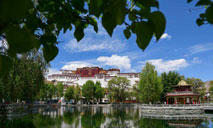A grain of barley witnesses Tibetan agricultural development
LHASA, April 30 (Xinhua) -- "Now the highland barley output is far greater than before, and the harvesting has been mechanized and become much more efficient," said Kelsang Namgyai while watering his barley field.
His barley was sown not long ago in Gonggar County in the city of Shannan, southwest China's Tibet Autonomous Region.
Kelsang Namgyai's views on barley production reflect the rapid advancement of Tibetan agriculture over the years, especially the past seven decades since the region's peaceful liberation.
For some 3,500 years, highland barley has been planted on the Tibetan plateau. It has long remained the crop with the largest planting area and the biggest share of the total grain output of Tibet.
Before Tibet's peaceful liberation in 1951, outdated and traditional farming methods had resulted in low productivity. In 1952, the grain yield in Tibet was only 80 kg per mu (about 667 square meters), according to local data.
After the region's democratic reform in 1959, serfs were allocated land, agricultural infrastructure was improved, and farming mechanization was gradually advanced.
Now, Tibet boasts more than 500,000 pieces of agricultural machinery and equipment, and the average farming mechanization rate stands at 65 percent.
Last year, the highland barley output was 795,000 tonnes, and the average output reached 381 kg per mu, both hitting all-time highs.
As output has increased, so too has the number of uses for barley. In the past, the crop was mainly for filling stomachs. Now, highland barley can be processed into dietary supplements, as people increasingly look to adopt healthier lifestyles.
Highland barley flour, tea and cookies are becoming more and more popular.
In 2016, Tibet Deqin Sunshine Manor Co., Ltd., a highland barley processing firm, was set up in the city of Shigatse as a poverty alleviation project supported by the regional government.
The company processes highland barley into products with high added value, such as snacks and dietary supplements.
While providing jobs to local residents, the company purchases more than 50,000 tonnes of barley from farmers each year, according to the company.
Thubten Khedrup, a professor at Tibet University, said highland barley is the witness of Tibet's development and changes over the past 70 years, reflects the region's agricultural modernization, and lays an important foundation for national food security.
This year, Tibet is planning to develop more land, improve the quality of 2 million mu of arable land, and ensure that its barley output exceeds 800,000 tonnes.
Photos
Related Stories
- Chinese agricultural heritages benefit world
- U.S. agricultural futures close mixed
- U.S. agricultural futures rise
- Spring farming underway across China
- China to ramp up prevention of pests, crop diseases: ministry
- Experts call for China-U.S. trade cooperation in agriculture
- China's spring farming goes high-tech thanks to modern agricultural technologies, machines
- Unmanned farm projects boost development of smart agriculture in China
- China's agricultural province achieves industrial upgrade with innovation
- China to fully advance rural vitalization, facilitate modernization of agriculture, rural areas
Copyright © 2021 People's Daily Online. All Rights Reserved.










